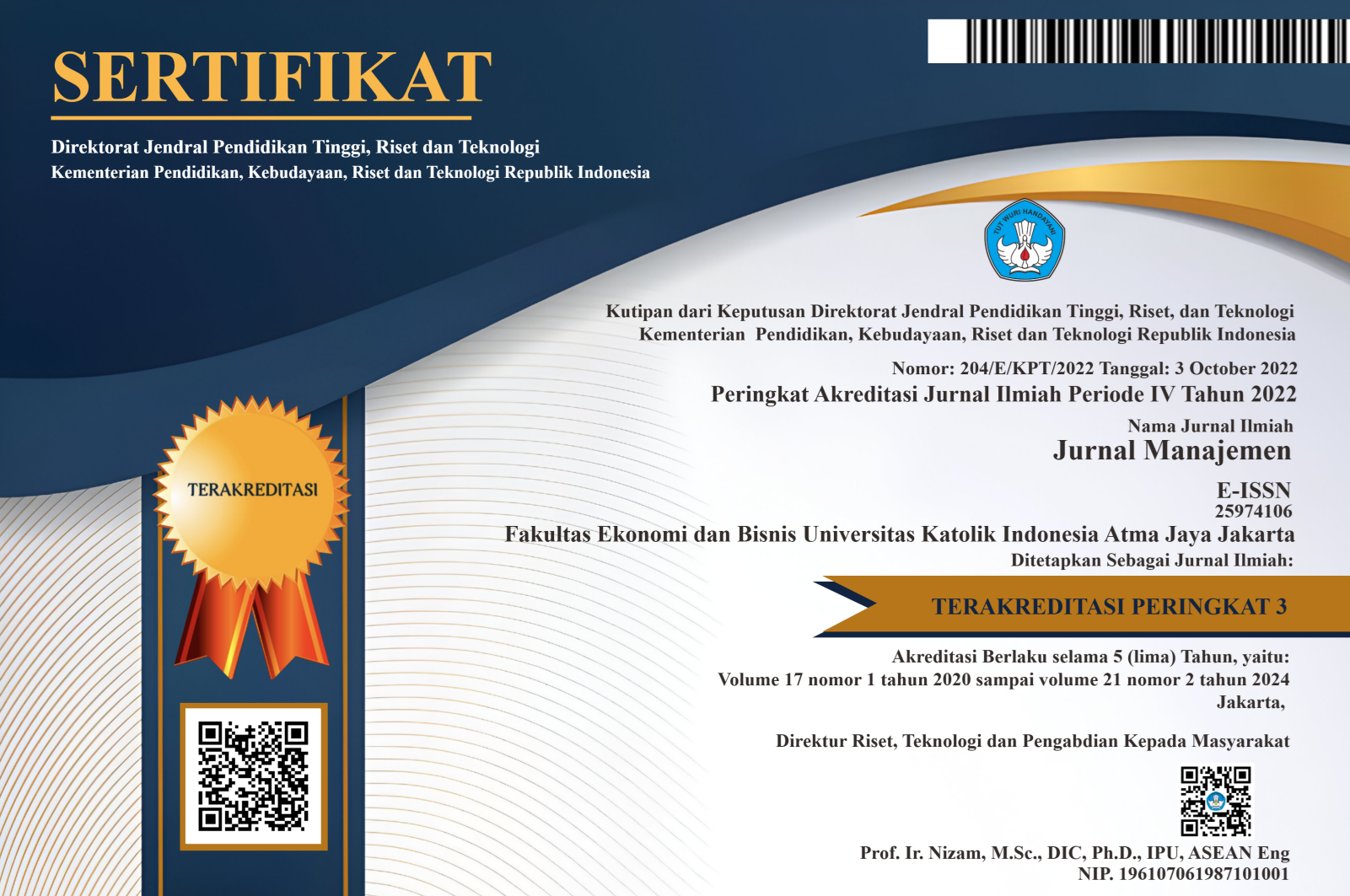INTERGENERATIONAL CONSUMER BEHAVIOR : A SYSTEMATIC REVIEW FROM 2001 UNTIL 2024
DOI:
https://doi.org/10.25170/jm.v22i1.6674Keywords:
Intergenerational Influence, Consumer Behavior, PRISMA, Systematic Literature ReviewAbstract
This systematic literature review explores the evolving landscape of intergenerational consumer behavior by analyzing 35 peer-reviewed articles, which were published between 2001 and 2024. Using the PRISMA framework, this review identifies the key pattern, mechanism, and cultural context that shape the consumers’ preference across generational cohort. The findings reveal a significant shift from the traditional unidirectional influence toward a bidirectional dynamic influence, where the younger generation increasingly influences the household consumption, specifically in digital and lifestyle related product category. This review uncovers six thematic clusters: Brand Identity and Emotional Meaning, Direction of Influence, Cultural Orientation, Lifestyle and Product Category, Advertising and Media Exposure, and Peer and Family Interaction.
References
Alic, A., Cinjarevic, M. (). Influence of Movie-related Online Consumer Reviews on Movie Choice: Are There Generational Differences in Processing Information Cues? Arts and the Market, 14(2), 150-171.
Bubphapant, J., & Brandao, A. (2025). Exploring Ageing Consumers Usage of Content Marketing Content Typlogy and Online Brand Advocacy. EuroMed Journal of Business, 20(5), 27-53.
Bravo, R., Fraj, E., & Martinez, E. (2007). Intergenerational Influences on the Dimensions of Young Customer-based Brand Equity. Young Consumers, 8(1), 56-64.
Carrigan, M., Wells, V., & Athwal, N. (2023). I’d Never Cook It Now: A Exploration of Intergenerational Transference and Its Role in Facilitating Family Food Sustainability. European Journal of Marketing, 57(5), 1352-1379.
Chan, K., Hongxia, Z., & Wang, I. (2006). Materialism among Adolescents in Urban China.
Young Consumer, 7(2), 64-77.
Chan, R.Y.K. (2001). Determinants of Chinese Consumer’s Green Purchase Behavior.
Psychology & Marketing, 18(4), 389-413.
Chaudhary M., Lopez, A., & Rodriguez, R. (2020). Children’s Relationship with Brands: Intergenerational and Transgression. Marketing Intelligence & Planning, 38(1), 75- 88.
Cotte, J., & Wood, S.L. (2004). Families and Innovative Consumer Behavior: A Triadic Analysis of Sibling and Parental Influence. Journal of Consumer Research, 31(1), 78-86.
Dou, W., Wang, G., & Zhou, N. (2006). Generational and Regional Differences in Media Consumption Patterns of Chinese Generation X Consumer. Journal of Advertising, 35(2), 101-110.
Duffy, B. (2013). Viewpoint: My Generation Shared Experiences Shape Individual Values and Attitudes. International Journal of Market Research, 55(4), 2-4.
Dubois, B., Czellar, S., & Laurent, G. (2005). Consumer Segments based on Attitudes toward Luxury: Empirical Evidence from Twenty Countries. Marketing Letters, 16(2), 115- 128.
Egri, C.P., & Ralston, D.A. (2004). Generation Cohorts and Personal Values: A Comparison of China and the United States. Organization Science, 15(2), 210-220.
Fu, G., Zhang, C., & Hu, J. (2021). Analysis of Progeny-Parents Family Travel Process from the Perspective of Filial Piety: Driving Factors, Intergenerational Interaction and Tourism Evaluation. Journal of Contemporary Marketing Science, 4(1), 1-21.
Fowler, J.G., Reisenwitz, T.H., & Fowler, A.R. (2104). Fashion Globally. Qualitative Market Research, 17(3), 172-191.
Gaitan, J.A., Peral, B.P., & Arroyo, J.R. (2022). Food-related Lifestyles Across Generations.
British Food Journal, 124(5), 1485-1501.
Gram, M., Hogg, M., Blichfeldt, B.S., & MacLaran, P. (2015). Intergenerational Relationship and Food Consumption: the Stories of Young Adults Leaving Home. Young Consumers, 16(1), 71-84.
Jiang, L., & Shan, J. (). Heterogeneity of Luxury Value Perception: A Generational Comparison in China. International Marketing Review, 35(3), 458-474.
Karanika, K., & Hogg, M.K. (2015). Consumption through The Ambivalent Prism of Intergenerational Support. European Journal of Marketing,
Khan, S., Fazili, A.I., & Bashir, I. (2022). Constructing Generational Identity through Counterfit Luxury Consumption. Journal of Product & Brand Management, 31(3), 415-437.
Lin, S., & Ke, X. (2010). Chinese Glocalization: A Study of Intergenerational Residence in Urban China. Journal of Consumer Marketing, 27(7), 638-644.
Liu, W., Li, W., & Mou, J. (2024). Does Internet Usage Make Middle-added and Older Adults Feel Healthier? Mediating Role of Social Engagement. Industrial Management & Data System, 124(1), 1-28.
Mandrik, C.A., Fern, E.F., & Bao, Y. (2005). Intergenerational Influence: Roles of Conformity to Peers and Communication Effectiveness. Psychology and Marketing, 22(10), 813-832.
Mandrik, C., Bao, Y., & Wang, S. (2018). A Cross-National Study of Intergenerational Influence: US and PRC. Journal of Consumer Marketing, 35(1), 91-104.
Mangleburg, T.F., Doney, P.M., & Bristol, T. (2004). Shopping with Friends and Teens Susceptibility to Peer Influence. Journal of Retailing, 80(2), 101-116.
Masuda, T., Gonzales, R., Kwan, L., & Nisbett, R.E. (2008). Culture and Aesthetic Preference Comparing the Attention to Context of East Asians and Americans. Personality and Social Psychology Bulletin, 34(9), 1260-1275.
Mooji, M.D. (2015). Cross-cultural Research in International Marketing: Clearing up Some of The Confusion. International Marketing Review, 32(6), 646-662.
Moore, E.S., Wikie, W.L. & Adler, J.A. (2001). Lighting the Torch: How do Intergenerational Influences Develop? Advances in Consumer Research, 28, 287-293.
Moore, E.S., & Wilkie, W.L. (2005). Consumer Socialization of Children: Retrospective and Prospective Research. Journal of Consumer Research, 31(1), 112-125.
Moore, E.S., Wilkie, W.L., & Lutz, R.J. (2002). Passing the Torch: Intergenerational Influence as a Source of Brand Equity. Journal of Marketing, 66(2), 17-37.
Moore, M. (2012). Interactive Media Usage Among Millenial Consumers. Journal of Consumer Marketing, 29(6), 436-444.
Moore, M., & Carpenter, J.M. (2008). Intergenerational Perceptions of Market Cues among US Apparel Consumer. Journal of Fashion Marketing and Management, 12(3), 323-337.
Ng, C.Y., Phillips, A.D., & Lee, W.K. (2002). Persistence and Challenges to Filial Piety and Informal Support of Older Person in a Modern Chinese Society: A Case Study in Tuen Mun. HongKong, Journal of Aging Studies, 16(2), 135-153.
Noble, S.M., Haytko, D.L., & Phillips, J. (2009). What Drives College-age Generation Y Consumers? Journal of Business Research, 62(6), 617-628.
Parameswaran, R. (2002). Local Culture in Global Media: Excavating Colonial and Material Discourses in National Geographic. Communication Theory, 12(3), 287-315.
Perez, M.E., Padgett, D., & Burgers, W. (2011). Intergenerational Influence on Brand Preferences. Journal of Product and Brand Management, 20(1), 5-13.
Podoshen, J.S., Lu, L., & Junfeng, Z. (2011). Materialism and Conspicuous Consumption in China: a Cross-cultural Examination. International Journal of Consumer Studies, 35(1), 17-25.
Rose, G.M., Boush, D., & Shoham, A. (2002). Familiy Communication and Children’s Purchasing Influence: A Cross-Sectional Examination. Journal of Business Research, 55(11), 867-873.
Schewe, C.D., & Noble, S.M. (2000). Market Segmentation by Cohorts: The Value and Validity of Cohorts in America and Abroad. Journal of Marketing Management, 16(1-3), 129-142.
Silverstein, M., Cong, Z., & Li, S. (2006). Intergenerational Transfers and Living Arrangements of Older People in Rural China: Consequences for Psychological Well- being. The Journal of Gerontology, 61(5), 256-266.
Wei, Y., Bergiel, B., & Song, L. (2018). Effects of Parental Cultural Capital on Purchase Intention of Cognac. International Journal of Wine Business Research, 31(3), 344- 361.
Wiedmann, K.P., Hennigs, N., & Siebels, A. (2009). Value-based Segmentation of Luxury Consumption Behavior. Psychology & Marketing, 26(7), 625-651.
Downloads
Published
Issue
Section
License
Copyright (c) 2025 Ignatius Hari Santoso, I Made Sukresna

This work is licensed under a Creative Commons Attribution-NonCommercial-ShareAlike 4.0 International License.
Authors who publish with this journal agree to the following terms:
Authors retain copyright and grant the journal right of first publication with the work simultaneously licensed under a Creative Commons Attribution-NonCommercial-ShareAlike License that allows others to share the work with an acknowledgement of the work's authorship and initial publication in this journal.
Authors are able to enter into separate, additional contractual arrangements for the non-exclusive distribution of the journal's published version of the work (e.g., post it to an institutional repository or publish it in a book), with an acknowledgement of its initial publication in this journal.
Authors are permitted and encouraged to post their work online (e.g., in institutional repositories or on their website) prior to and during the submission process, as it can lead to productive exchanges, as well as earlier and greater citation of published work (See the Effect of Open Access).












